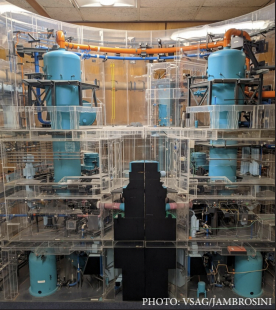Mitigating Millstone Misconceptions

It’s hard to miss the Millstone Power Plant on the shoreline: a pile of square gray buildings overseen by the tall red-and- white tower, like presents under a leafless Christmas tree. Millstone is a unique part of EL, but some people aren’t aware of its purpose and contribution. Take, for example, the siren tests every first Wednesday of the month. For an average EL resident, it comes as nothing more than a slight surprise in your day, but for someone like sophomore Kathleen Correa, who just moved to EL in October, it was a harrowing experience the first time. “Both my parents texted me asking if I was alright, and we were all confused,” Correa said. The sirens aren’t something to be concerned about, however, as their monthly use is only to test that they’re still able to alert people about a potential emergency at Millstone. The sirens are one of many safety mechanisms tested by Millstone to keep EL safe in the event of an emergency. But to a new resident or visitor, it comes as a surprise. In the event of an actual emergency, messages might be broadcast through the siren’s speakers to let residents know of any problems. One concern people may have is Millstone’s effect on the environment. The billowing clouds coming fromthe plant’s cooling stacks can make some people jump to conclusions about radioactive materials spilling into the air, but in reality, it’s nothing more than harmless steam. The power plant provides energy by splitting uranium, releasing huge amounts of energy. This energy heats the water pool that surrounds the uranium-filled core, which prevents the reaction from occurring too fast. The heat turns a turbine that produces electricity. The steam released into the air from heating the water is not radioactive, and the water, drawn from the Long Island Sound, sees no changes as it passes through apart from being warmer as it leaves. “We have minor emissions if we’re using the emergency diesel generators (in the event of an outage), but other than that, no air emissions,” vice president of Millstone Michael O’Connor said. According to Dominion Energy, the company that runs Millstone, the plant provides 98 percent of the carbon-free electricity in Connecticut, and around half of all total electricity. Millstone is also New England’s only multi-unit nuclear power plant, which makes it all the more able to provide enough electricity for the area. Each one centimeter long uranium pellet that fuels the reactor has the same amount of energy as 48 coal-filled train cars. “When properly run, nuclear power is one of the safest, cleanest forms of energy we’ve got,” chemistry teacher Lori Singer said. Ms. Singer loved being able to see the power plant from her roof when she moved to EL, and she doesn’t want it to go anytime soon. People may still be wary of living so close to a nuclear energy plant, but Millstone has been awarded the “Star” status by Occupational Safety and Health Administration (OSHA), its highest safety recognition, for its procedures to keep employees and residents safe. Long-term residents such as the Fields family agree with OSHA. “I am confident that there is nothing that can go wrong that wouldn’t be caused intentionally,” sophomore Luke Fields said. Fields has lived in EL his entire life without concern, and his parents have done the same. So, the next time you’re at the beach and you see Millstone in the distance, know you can rest easy and appreciate this useful part of EL.
Your donation will support the student journalists of East Lyme High School. Your contribution will allow us to purchase equipment and cover our annual website hosting costs.

Hi everyone! My name is James, and I’ll be one of your editors-in-chief for my third and final year of Journalism. It’s been really fun to...
